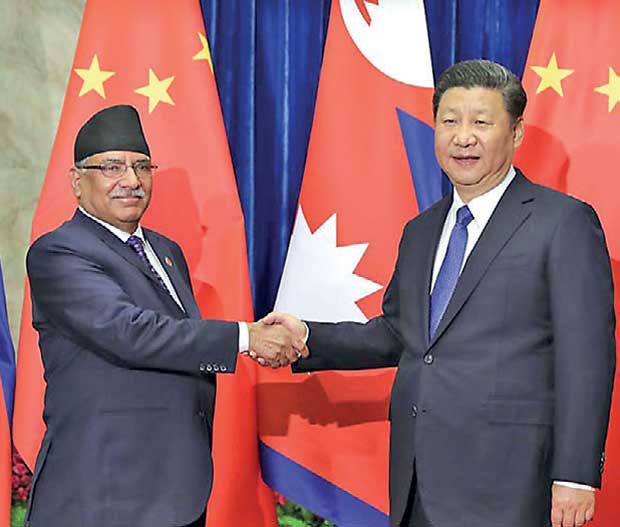21 Jun 2017 - {{hitsCtrl.values.hits}}

By Bishal Chalise
On May 12, Nepal signed a memorandum of understanding (MoU) with China to cooperate on the Belt and Road Initiative (BRI). The timing of the agreement, signed just two days before the Belt and Road Forum in Beijing, is not surprising.
For its part, China wanted to amplify support for its ‘grand project’ before the forum and to increase the count of participant countries. Across the border, the BRI presented Nepal with an opportunity to strengthen economic ties with China and lessen its singular economic and political dependence on India. This has been a particular concern for Nepal’s government after its southern neighbour resorted to an unofficial border blockade over the country’s constitution writing process in 2015. In that sense, the BRI has not been an especially tough sell to Nepal.
Policymakers in Nepal share a general sense of optimism towards the BRI — so much so that the signing of the MoU has been touted as a major achievement of the current government. The key driver of the excitement is potential Chinese investment in a cross-border rail and road network.
The need for connectivity is palpable. The World Bank projects that the country needs infrastructure investment equivalent to 12 percent of gross domestic product (GDP), which amounts to nearly US $ 13–18 billion over a decade, to maintain the current pace of economic growth. The transportation sector alone needs anywhere between US $ 3.7–5.5 billion in investment for new projects. Foreign investment is critical to closing this gap.
China has presented itself as a reliable development partner in recent years amid blossoming bilateral ties. The country is not only providing massive development assistance but also promoting foreign direct investment in crucial sectors like energy, transportation and tourism.
In 2015–16, China invested around US $ 621 million — nearly 42 percent of total foreign direct investment into Nepal that year. China has earned an image as a reputable and trustworthy neighbour, which greatly explains Nepal’s positivity towards the BRI.
Nevertheless, there are some rare acknowledgements that the BRI is still in gestation and has no concrete action plan for Nepal. There are also concerns that even if the project moves ahead as envisioned, Nepal would just be periphery to development and that benefits to the country would be limited. These are not completely unfounded given the BRI in its current form.
Against this backdrop, implementation of the MoU in Nepal would look like no more than repackaging of ongoing projects under the banner of the BRI. China is investing in two large hydropower projects, one international airport, two special economic zones and a cross-border transmission line. Some of these projects were started years before the announcement of the BRI.
Similarly, there are several high-level discussions to extend the Beijing–Lhasa Expressway on to Lumbini near the Nepal–India border and to extend the Qinghai–Tibet Railway on to Kathmandu. It is very unlikely that the BRI would bear any other fruit beyond continuing these projects
anytime soon.
But it is not only ‘repackaging’ concerns which are engendering scepticism.
First, there is very little understanding about the initiative. There has not been enough public discussion on the issue and many questions remain unanswered. What would happen if Nepal merely becomes a way station on the Chinese rail route to India or other South Asian countries? Would it be economically beneficial to trade with Chinese hinterland cities thousands of kilometres away via rail compared to the populous Indian cities just a few kilometres across the border? How will Nepal balance existing trade relations that are already heavily skewed towards China? What will be the implications beyond infrastructure connectivity?
Second, there are environmental and ecological concerns regarding the infrastructural projects linking China and Nepal. The Himalayas separate the two countries and any connectivity infrastructure has to pass through this mountainous range — which is already considered highly ecologically vulnerable due to climate change. Although the exact effects of building infrastructure are not yet known, Nepal is likely to pay an extra price for any large-scale construction on the fragile terrain.
Finally, Indian resentment towards the BRI might derail or delay its implementation in Nepal. Delhi fears strategic motives in the guise of economic projects and might be apprehensive about any BRI-related project that challenges the clout it has traditionally enjoyed in Nepal.
But these challenges are not insurmountable and can be resolved in due course. More information about the BRI can assuage the doubts. The MoU needs to be translated into tangible outcomes for both Nepal and China — if that happens, the BRI can be a win-win game not just for the two countries, but for regional integration and development in South Asia.
(Courtesy East Asia Forum)
(Bishal Chalise is a graduate of the Crawford School of Public Policy, The Australian National University)
25 Nov 2024 17 minute ago
25 Nov 2024 38 minute ago
25 Nov 2024 52 minute ago
25 Nov 2024 1 hours ago
25 Nov 2024 2 hours ago